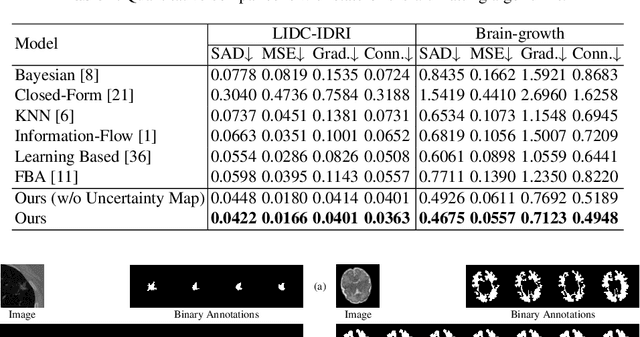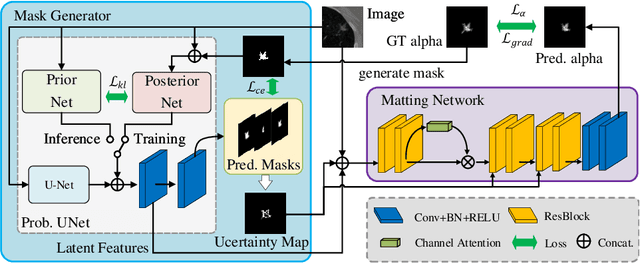Xiufen Ye
When SAM Meets Sonar Images
Jun 25, 2023Abstract:Segment Anything Model (SAM) has revolutionized the way of segmentation. However, SAM's performance may decline when applied to tasks involving domains that differ from natural images. Nonetheless, by employing fine-tuning techniques, SAM exhibits promising capabilities in specific domains, such as medicine and planetary science. Notably, there is a lack of research on the application of SAM to sonar imaging. In this paper, we aim to address this gap by conducting a comprehensive investigation of SAM's performance on sonar images. Specifically, we evaluate SAM using various settings on sonar images. Additionally, we fine-tune SAM using effective methods both with prompts and for semantic segmentation, thereby expanding its applicability to tasks requiring automated segmentation. Experimental results demonstrate a significant improvement in the performance of the fine-tuned SAM.
3D Matting: A Benchmark Study on Soft Segmentation Method for Pulmonary Nodules Applied in Computed Tomography
Oct 11, 2022



Abstract:Usually, lesions are not isolated but are associated with the surrounding tissues. For example, the growth of a tumour can depend on or infiltrate into the surrounding tissues. Due to the pathological nature of the lesions, it is challenging to distinguish their boundaries in medical imaging. However, these uncertain regions may contain diagnostic information. Therefore, the simple binarization of lesions by traditional binary segmentation can result in the loss of diagnostic information. In this work, we introduce the image matting into the 3D scenes and use the alpha matte, i.e., a soft mask, to describe lesions in a 3D medical image. The traditional soft mask acted as a training trick to compensate for the easily mislabelled or under-labelled ambiguous regions. In contrast, 3D matting uses soft segmentation to characterize the uncertain regions more finely, which means that it retains more structural information for subsequent diagnosis and treatment. The current study of image matting methods in 3D is limited. To address this issue, we conduct a comprehensive study of 3D matting, including both traditional and deep-learning-based methods. We adapt four state-of-the-art 2D image matting algorithms to 3D scenes and further customize the methods for CT images to calibrate the alpha matte with the radiodensity. Moreover, we propose the first end-to-end deep 3D matting network and implement a solid 3D medical image matting benchmark. Its efficient counterparts are also proposed to achieve a good performance-computation balance. Furthermore, there is no high-quality annotated dataset related to 3D matting, slowing down the development of data-driven deep-learning-based methods. To address this issue, we construct the first 3D medical matting dataset. The validity of the dataset was verified through clinicians' assessments and downstream experiments.
3D Matting: A Soft Segmentation Method Applied in Computed Tomography
Sep 16, 2022



Abstract:Three-dimensional (3D) images, such as CT, MRI, and PET, are common in medical imaging applications and important in clinical diagnosis. Semantic ambiguity is a typical feature of many medical image labels. It can be caused by many factors, such as the imaging properties, pathological anatomy, and the weak representation of the binary masks, which brings challenges to accurate 3D segmentation. In 2D medical images, using soft masks instead of binary masks generated by image matting to characterize lesions can provide rich semantic information, describe the structural characteristics of lesions more comprehensively, and thus benefit the subsequent diagnoses and analyses. In this work, we introduce image matting into the 3D scenes to describe the lesions in 3D medical images. The study of image matting in 3D modality is limited, and there is no high-quality annotated dataset related to 3D matting, therefore slowing down the development of data-driven deep-learning-based methods. To address this issue, we constructed the first 3D medical matting dataset and convincingly verified the validity of the dataset through quality control and downstream experiments in lung nodules classification. We then adapt the four selected state-of-the-art 2D image matting algorithms to 3D scenes and further customize the methods for CT images. Also, we propose the first end-to-end deep 3D matting network and implement a solid 3D medical image matting benchmark, which will be released to encourage further research.
A Novel Unified Self-alignment Method of SINS Based on FGO
Jun 29, 2022



Abstract:The self-alignment process can provide an accurate initial attitude of SINS. The conventional two-procedure method usually includes coarse and fine alignment processes. Coarse alignment converges fast because of its batch estimating characteristics and the initial attitude does not influence the results. But coarse alignment is low accuracy without considering the IMU's bias. The fine alignment is more accurate by applying a recursive Bayesian filter to estimate the IMU's bias, but the attitude converges slowly as the initial value influence the convergence speed of the recursive filter. Researchers have proposed the unified self-alignment to achieve self-alignment in one procedure, existing unified methods make improvements on the basics of recursive Bayesian filter and those methods are still slow to converge. In this paper, a unified method based on batch estimator FGO (factor graph optimization) is raised, which is converge fast like coarse alignment and accurate than the existing method. We redefine the state and rederivation the state dynamic model first. Then, the optimal attitude and the IMU's bias are estimated simultaneously through FGO. The fast convergence and high accuracy of this method are verified by simulation and physical experiments on a rotation SINS.
Medical Matting: A New Perspective on Medical Segmentation with Uncertainty
Jul 08, 2021



Abstract:In medical image segmentation, it is difficult to mark ambiguous areas accurately with binary masks, especially when dealing with small lesions. Therefore, it is a challenge for radiologists to reach a consensus by using binary masks under the condition of multiple annotations. However, these areas may contain anatomical structures that are conducive to diagnosis. Uncertainty is introduced to study these situations. Nevertheless, the uncertainty is usually measured by the variances between predictions in a multiple trial way. It is not intuitive, and there is no exact correspondence in the image. Inspired by image matting, we introduce matting as a soft segmentation method and a new perspective to deal with and represent uncertain regions into medical scenes, namely medical matting. More specifically, because there is no available medical matting dataset, we first labeled two medical datasets with alpha matte. Secondly, the matting method applied to the natural image is not suitable for the medical scene, so we propose a new architecture to generate binary masks and alpha matte in a row. Thirdly, the uncertainty map is introduced to highlight the ambiguous regions from the binary results and improve the matting performance. Evaluated on these datasets, the proposed model outperformed state-of-the-art matting algorithms by a large margin, and alpha matte is proved to be a more efficient labeling form than a binary mask.
 Add to Chrome
Add to Chrome Add to Firefox
Add to Firefox Add to Edge
Add to Edge